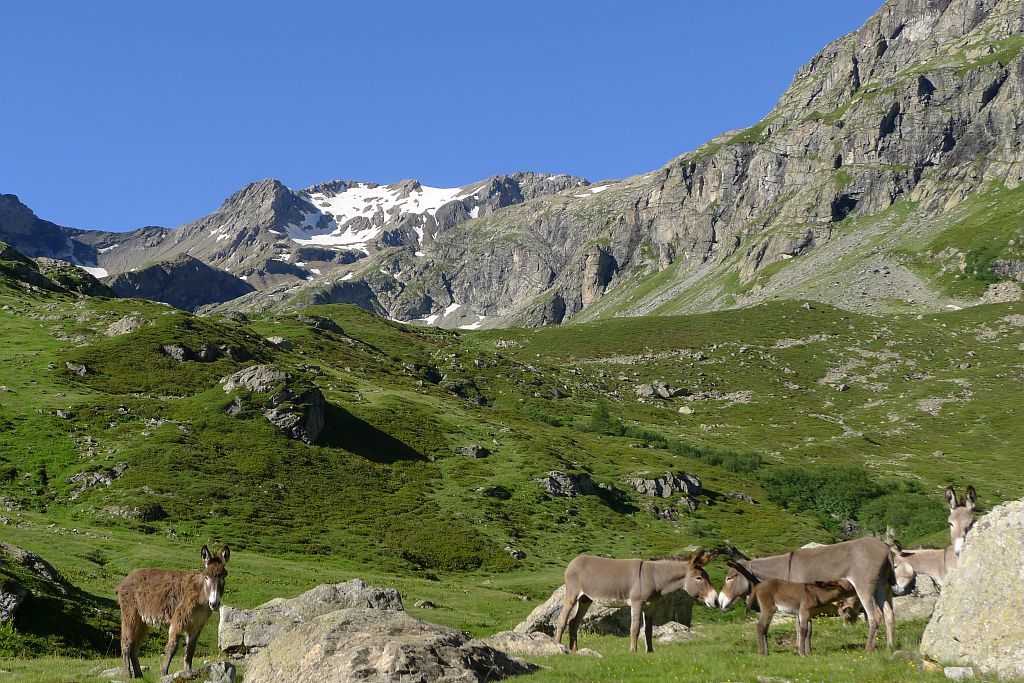
6. From Vallouise to Le Pré de la Chaumette via Col de l’Aup Martin (stage of the GR 54)
We leave behind the gentle Vallouise along the Onde mountain stream. This preserved valley leads to the mountain pastures at the confluence of the streams of Entre-les-Aygues (“between the waters”). Then, as the path rises, the landscape becomes more austere. Col de l'Aup Martin stands with its black schist like an insurmountable barrier. And finally, the steep descent towards Pré de la Chaumette, to be approached with care, makes this stage one of the highlights of the adventure through the Ecrins.
Description
From Place de la Fontaine in Vallouise (1 170 m), turn left towards the Aiglière gîte.
- You arrive at the Fontaines bridge (1 185 m). Cross the Onde mountain stream and follow it along the right bank as far as the Places bridge (1 237 m). The GR route now follows the road, passing in front of Notre-Dame de Béassac until reaching Entre-les-Aygues car park (1 604 m). This is where the road ends, at the bottom of the Onde valley and at the confluence of the Selle and Bans mountain streams.
- Take the footpath on the left. It crosses the Onde over a footbridge, towards ""Col de l'Aup Martin"". Follow the cairns in the Onde riverbed to return to the footpath, which follows the Selle as far as the Jas Lacroix pastoral hut (1 946 m). The hut stands beside a shelter for GR54 footpath hikers. Continue along the footpath as it weaves its way to the bottom of the valley, pass a projection near a fine waterfall, then walk along the edge of the south-facing slope, in places between the large walls of stone, as far as an area of schist at the foot of Aup Martin. The path leads up across large rocky screes, and the last part of the crossing is the trickiest because the footpath disappears. You need to climb up with your hands for the last 100 metres before finally crossing Col de l'Aup Martin (2761m). Cross the side of the mountain under the peak of the Cavale, pass a rocky spur and you arrive at Le Pas de la Cavale (2 735 m).
- Descend the well-marked footpath crossing the rocky bars and then a series of streams before reaching the Rognoux plateau (2 070 m).
- At the Rougnoux hut, pass the footpath on the left that leads to Col du Cheval de Bois. Walk across the footbridge over the Rognoux mountain stream and you arrive at Le Pré de la Chaumette (1 790 m).
- Departure : La Vallouise
- Arrival : Le Pré de la Chaumette, Champoléon
- Towns crossed : Vallouise-Pelvoux, L'Argentière-la-Bessée, and Champoléon
Altimetric profile
Sensitive areas
Alpine ibex
- Impacted practices:
- Aerial, , Land, Vertical
- Sensitivity periods:
- JunJulAugSep
- Contact:
- Parc National des Écrins
Julien Charron
julien.charron@ecrins-parcnational.fr
Golden eagle
- Impacted practices:
- Aerial, , Vertical
- Sensitivity periods:
- JanFebMarAprMayJunJulAug
- Contact:
- Parc National des Écrins
Julien Charron
julien.charron@ecrins-parcnational.fr
Alpine ibex
- Impacted practices:
- Aerial, , Land, Vertical
- Sensitivity periods:
- JunJulAugSep
- Contact:
- Parc National des Écrins
Julien Charron
julien.charron@ecrins-parcnational.fr
Golden eagle
- Impacted practices:
- Aerial, , Vertical
- Sensitivity periods:
- JanFebMarAprMayJunJulAug
- Contact:
- Parc National des Écrins
Julien Charron
julien.charron@ecrins-parcnational.fr
33 points of interest
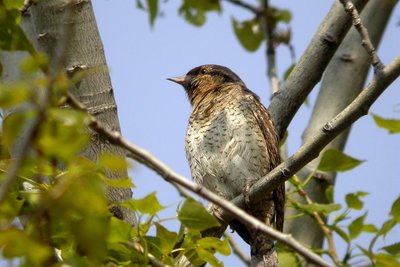
Torcol fourmilier - Damien Combrisson - Parc national des Écrins  Fauna
FaunaThe northern wryneck
The old trees in the orchard are home to the northern wryneck. It has a loud song, rather like that of the green woodpecker, only slower. This bird owes its name to the extreme way it extends and twists its neck when it feels threatened. Its French name torcol fourmilier is a reference to the fact that it feeds on ants (fourmils in French). Difficult to spot because its plumage merges into the colour of the tree trunks, it gives its presence away by its song when it returns from its migration.
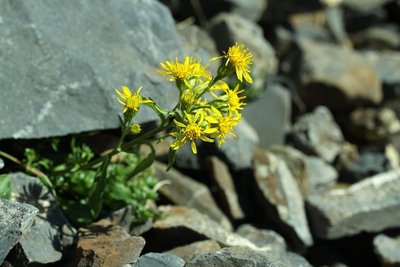
Petite verge d'or - Cédric Dentan - Parc national des Écrins  Flora
FloraThe great goldenrod
In damp spots on the edge of the track, swathes of tall plants grow. It forms great plumes of tiny yellow plants. The great goldenrod, still known as the tête d'or or "head of gold" is a plant native to North America and introduced into Europe in the eighteenth century as an ornamental. Since then, it has colonised a large are of Europe and in some places it even competes with the local flora.
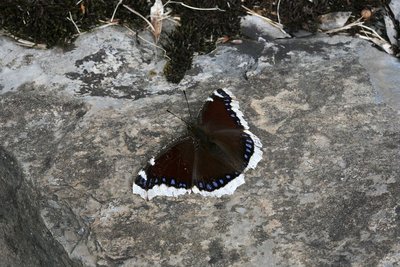
Le morio - Bernard Nicollet - Parc national des Écrins  Fauna
FaunaThe morio
With wings edged with creamy white and sporting a string of little blue dots, a large butterfly takes flight from the path as the walker approaches. This is the morio. Its common French name is manteau royal, or royal cloak (although her cloak is not edged with ermine!) It lives near willow and beech trees because it loves the sap that flows from wounds in these trees. It is one of the few butterflies to hibernate as an adult.
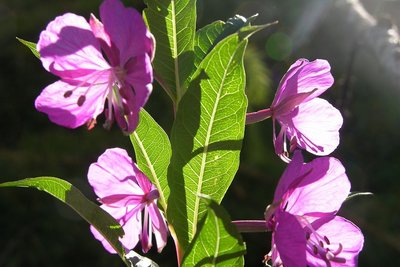
Epilobe en épis - Thierry Maillet - Parc national des Écrins  Flora
FloraThe rosebay willowherb
The rosebay willowherb is a tall, upright plant with elongated leaves. Its numerous purple-pink flowers are arranged in loose spikes at the top of the stem. It forms large clumps, which produce a beautiful display when in bloom. It is a pioneer plant and favours road embankments and disturbed ground. In late summer, its very numerous seeds, each with a little plume, float away en masse glowing in the advancing twilight…
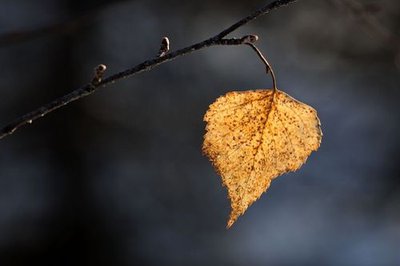
Feuille de bouleau - Mireille Coulon - PNE  Flora
FloraSilver birch
On the edge of the Onde, once you have crossed the footbridge, the stone footpath weaves its way between the birch trees. This tree is easy to recognize amongst all the others due to it thin white bark. Due to the tar that it contains, birch bark stays intact even after the wood has rotted inside. It was used as parchment and as tannin in boreal regions. In this area, the birch's young twigs were mostly used to make brooms.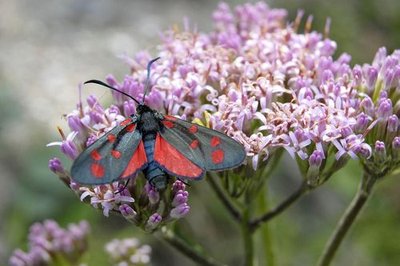
Zygène transalpine - Mireille Coulon - PNE  Fauna
FaunaSoutherly burnet
These small moths that come out during the day, are part of thirty species of burnet in France. Their long wings are black or sometimes bluish and have red spots. Such bright colours are a warning of toxicity to their predators. Burnets are capable of extracting chemical components similar to cyanide from plants. They then secrete this poison through their mouth and joints when faced with danger
Aulne vert - Bernard Nicollet - PNE  Flora
FloraGreen alder
This bushy shrub grows in entangled thickets, which are a refuge to birds and chamois that are in search of coolness and quiet. It is a pioneer and not afraid of settling in poor, steep terrains. Its strong roots mean it can latch on where everything else slides. Its flexibility means avalanches slide over it as it bends under the weight of the snow. The male catkins dangle when they are mature showing the pale yellow of their flowers. The female flowers will bear characteristic fruit like small pinecones that are first green, and then brown that persist all year round.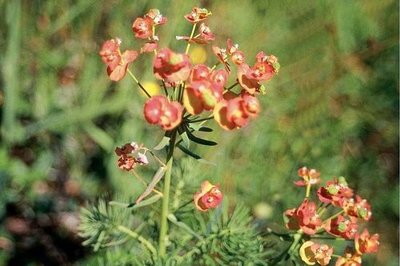
Euphorbe faux cyprès - Catherine Boutteau  Flora
FloraCypress spurge
This is also referred to as "milk herb" in relation to the sticky white liquid that flows when it is cut. This is a toxic, irritating latex. It is identifiable due to its thin soft leaves and its original flowers that change colour and group together in inflorescence. By looking closer, in the middle of a 'cup' made from two bracts, it is possible to distinguish a female flower which is reduced to a ball (ovary) on a long stem, and males flowers with a sole stamen and four crescent-shaped nectar glands.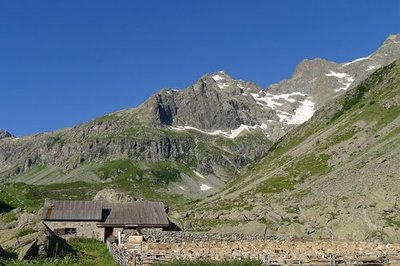
Brebis parquées près de la cabane de Jas Lacroix - Thierry Maillet - PNE  Pastoralism
PastoralismThe pastoral hut and the walkers' shelter
The Jas Lacroix pastoral hut is where the shepherd lives during the mountain pasture period. This where she herds the flock to count or nurse the animals. To the right of the hut there is a shelter for walkers on the GR54 route. It is maintained by a volunteer from the valley. Please leave it in the state of cleanliness you would like to find it.
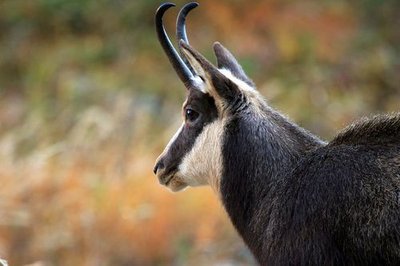
Chamois mâle dans le vallon de Celse Nière - Christophe Albert - PNE  Fauna
FaunaChamois
In the summer, it is at the coolest times of the day that you are likely to see a chamois busy grazing. When the sun heats the valley, they prefer to lie in the shade of the green alders, or otherwise stay on the névés. Their hearing and their sense of smell are highly developped and makes it difficult to approach them. You will need binoculars to see them. If the end of their horns are curved, it's a male, a buck. Open horns, it's a female, a doe. If the horns are shorter than the ears, it's an 'éterlou', a young male chamois in its second year. Barely visible horns, it's a kid.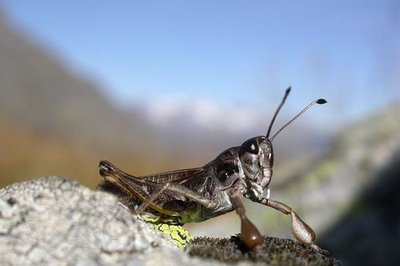
Gomphocère des alpages - Blandine Delenatte - PNE  Fauna
Fauna"Popeye" grasshopper
In the pastures, in August, tens of grasshoppers jump and then disappear into the grass with each of our footsteps. Amongst them, the most original is perhaps the gomphocerus sibiricus nicknamed Siberian grasshopper, due to its resistance to the cold. The male is also known as the "Popeye grasshopper" because of its 'muscled' front legs. Its green-brown colour might mean it would go unnoticed were it not for this anatomical detail and it long, consistent "cre-cre-cre-cre" ending with a couple of separate "cre" that it repeats in order to attract a female.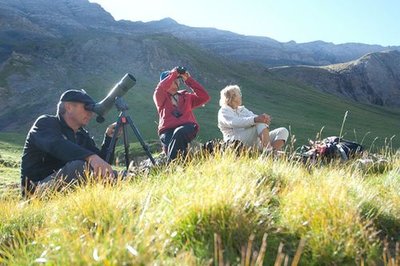
Jean-Philippe Telmon anime une sorties observation des bouquetins - Pierre Masclaux  Fauna
FaunaThe alpine ibex
In 1995 several ibex were introduced into the Champsaur. Since then, their population has steadily progressed to the valleys of the massif. A small group of ibex spend the summer season on the cliffs of the Chanteloube valley that overlooks the Jas Lacroix hut, on the left bank. They are more often than not perched on the rock faces and are difficult to see but from the hilltop above the hut, you might be lucky enough to see one on the rocks with the help of a telescope.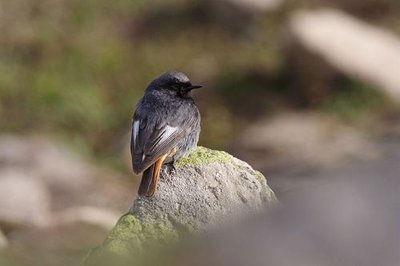
Rougequeue noir mâle - Jean-Philippe Telmon - PNE  Fauna
FaunaBlack redstart
The black redstart has a grey crown, a white patch on its wings and a tan tail and rump. A lively and active common bird, it likes the rocky environments and constantly hunts insects in flight or on the ground. Perched on a rock or a stone wall, it gives out brief cries of warning whilst folding it feet. Its chatty song interrupted by "paper rustling" is characteristic. This partly migratory bird can be seen at high altitude during the summer but heads to the lower valleys for the winter.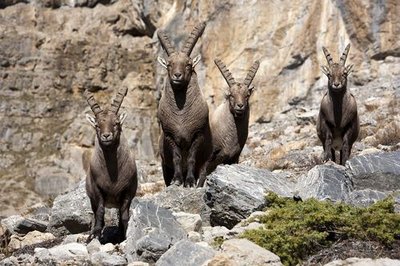
Quatre bouquetins dans le massif des Cerces - Cyril Coursier - PNE  Fauna
FaunaThe ibex, a survivor
In the face of danger, the ibex does not run away but takes refuge on a rock face where it thinks it will be safe. This strategy has enabled it to escape from land predators for thousands of years. However, it has proved to be inefficient against man since the invention of the crossbow or the rifle. As a result, the ibex was almost wiped out in the 19th century. The species owes it survival to Italy's protection in the creation of a royal reserve, that later became the Gran Paradiso National Park.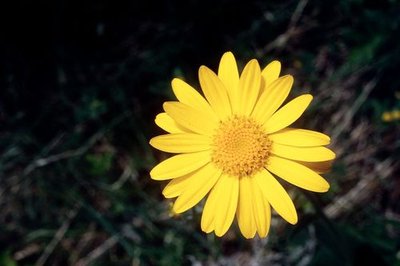
Séneçon doronic - Bernard Nicollet - PNE  Flora
FloraChamois ragwort
In June it impossible not to see these large yellow sun-like flowers on the edge of the path. Their greyish, fleshy leaves look like they have grown through a spider's web. At the end of July they are unrecognisable: the leaves turn green and no longer have the grey fluff. Once the flowers have wilted, they give way to a fluffy white seed head that is easily scattered by the wind. Our elders used to compare them to an old man's hair (senex in Latin) which lead to the French name "séneçon".
Rhubarbe des moines - Christophe Albert - PNE  Flora
FloraMonk's Rhubarb
Around the pastoral hut, monk's rhubarb forms an ocean of bright green. This species along with Good King Henry and stinging nettles have a love for ample manure. They therefore create vast fluffy carpets on the animals' resting places and around the pastoral huts where they stifle out most of the other vegetation due to its vigorous germination and the damp shade of its large leaves. On its stem, the flower heads that look like candles are made up of uncountable greenish flowers that, when mature, will become winged, three-sided brown fruit. The leaf petioles of this wild rhubarb, which are fleshy, juicy and tangy, can be used in cooking.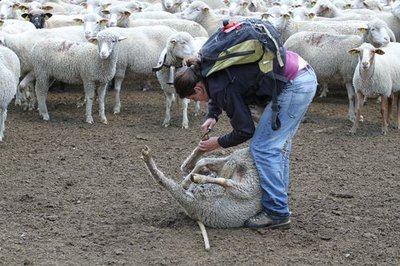
Soin aux brebis - Jean-Philippe Telmon - PNE  Pastoralism
PastoralismPastoral activity in the Selle valley, dale
Between l’Aup Martin pass and Entre les Aygues, the Selle valley is the communal pasture for Vallouise. During the summer, the pasture is grazed by a flock of sheep, a herd of cows, a few horses and the donkeys that accompany the shepherds. The shepherd's role is to not only keep and guide the sheep on the pasture with the help of dogs. She also nurses them, in particular to avoid foot-rot, a bacterial infection of the hooves that could spread to wild animals.
Cincle plongeur - Mireille Coulon - PNE  Fauna
FaunaWhite throated dipper
Stocky, short-tailed with a slender beak, it has a white patch from chin to chest and the rest of its plumage is ginger to slate grey. This is the portrait of this fantastic stream-loving bird. Standing on a large, half-immersed stone, it rocks with its tail out. Then suddenly it dives head first into the turbulent water. One of its features is walking upstream in the water in search of food such as small invertebrates that it uncovers by moving pebbles with its beak.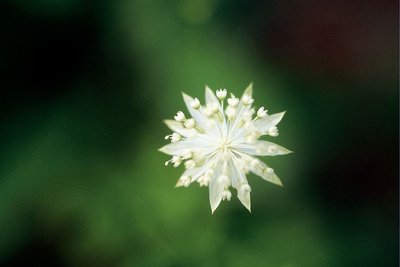
Petite astrance - Bernard Nicolet - PNE  Flora
FloraAstrantia minor
At the top of a thin and fragile, divided stem, four or five small, delicate white stars move in the slightest breeze. The astrantia minor's umbels brighten up the shady areas that it likes under the shrubs on the moors. Its fanned, finely serrated leaves at the end of a long petiole, do their best to emerge from the vegetation.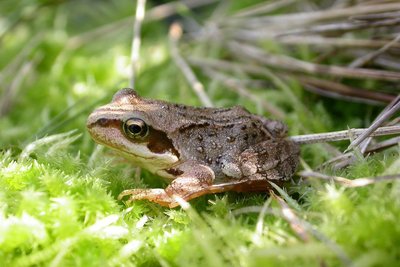
Grenouille rousse sur un lit de mousse - Jean-Philippe Telmon - PNE  Fauna
FaunaCommon frog
After the glacial cross-cliff above the Jas Lacroix mountain hut, not far from the footpath leading to the pass, there is a small lake that is home to the common frog. This is the most common frog in the Alps. It can live up to 2800 m in altitude, a record! It has a chocolate coloured mask around its golden eyes.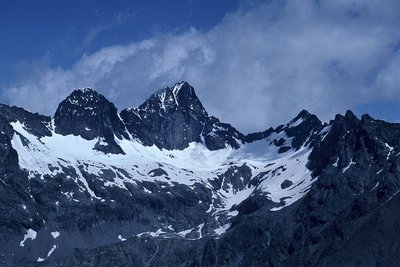
Pointe de Verdonne, face Sud, vue du Rouite - François Labande - PNE  Top
TopVerdonne Point
Above the Jas Lacroix hut, the Chanteloube valley opens up to the right in the form of a cirque. The highest peak in the cirque is the Verdonne point, which rises to 3328m. Sometimes a glittering object can be seen at its summit. This a Grand Réseau Radio des Alpes (GRA) radio relay station, serving the mountain rescue network. It is used to make radio contact with police and emergency services in Briançon.
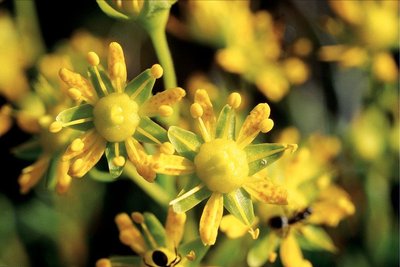
Saxifrage des ruisseaux - Bernard Nicollet - PNE  Flora
FloraYellow (mountain) saxifrage
At the edge of the clear waters of the brook, a flowerbed of yellow stars catches the eye. When young, the flowers are male and only have 10 stamen and a large shiny disc full of nectar. Later, when the stamen have fallen off, they become female and two small nipples appear on the nectar disc, ready to welcome pollen from a younger neighbour. The small rare and protected apollo butterfly has chosen this plant to protect its eggs and feed its caterpillars.
Myrtilles mûres - Christophe Albert - PNE  Flora
FloraBlueberry
This shrub does not venture much higher than the last trees where it constitutes the moors that cover the ground along with other shrubs. Its finely serrated, light green leaves, ever green branches and juicy, sweet, black fruit that turn your tongue purple, make it possible to distinguish it from its cousins. The berries are a true treasure of the mountains and are used for many culinary and medicinal purposes.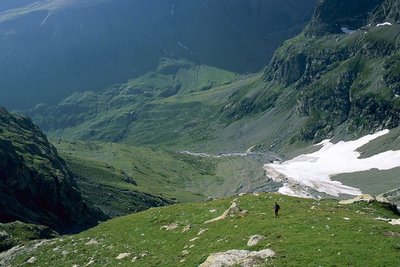
Le vallon de la Selle - Robert Chevalier - PNE  Pastoralism
PastoralismCattle
The Selle valley is the Vallouise communal pasture where breeders take their animals in the summer. The pasture is divided into sectors where sheep, cattle and horses graze. Each group moves according to the growth of the grass and they rarely mingle, if at all.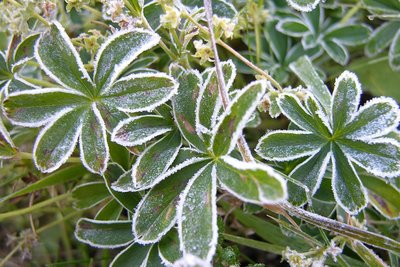
Feuilles d'Alchemille avec givre - Thierry Maillet - PNE  Flora
FloraAlpine lady's-mantle
Lush foliage, five to seven elegant leaflets, simple inflorescence, this plant is also known as "satin lion's foot", and is common along the footpath. This nickname comes from the underside of the leaves. Its flowers are not very attractive to insects. It does not need them for pollination. Its seeds develop spontaneously, without being fertilised: this is called apogamy. Is this why it is used as an infusion by the women of the high areas in all fields of gynaecology?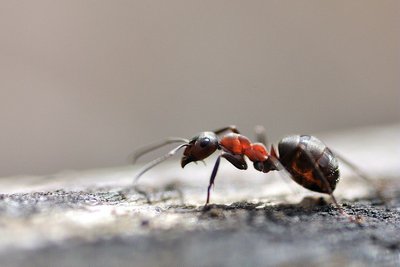
Fourmi rousse des bois - Mireille Coulon - PNE  Fauna
FaunaRed ants
A mound of twigs abounds with life at the edge of the footpath. An anthill in full action. On average it will house 300 000 red ants. This sociable insect is the epitome of perfection. It has strong jaws for digging, cutting and transporting; antennae for communicating and orientating; three pairs of non-slip feet for getting about; compound eyes to see as with a kaleidoscope; a chitin armour and a reserve of formic acid with which to attack. A simple experiment: put your hand close to the anthill, without touching it. Let the ants react then put your tongue to your hand...formic acid!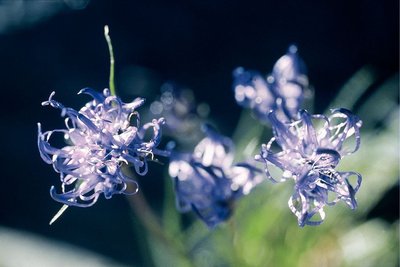
Raiponce hémisphérique - Bernard Nicollet - PNE  Flora
FloraRampion
Rampion is a pretty, blue flower. On the way up to the Aup Martin pass, it is possible to admire rampion in the prairies and rocky areas at high altitude. A small ball of shiny purple-blue petals and scruffy stamen, it is perched on the top of a short stem surrounded by short narrow leaves.
 History
HistoryWalls
Above the Saume ravine, the footpath’s tight loops are supported by stone walls, the remains of the mule-driver’s path that the army once kept maintained, just in case, between Vallouise and Champoléon...
Champoléon farmers once took their livestock along the path to the Vallouise sheep fair on 4 October.

Marmotte des Alpes - Jean-Philippe Telmon - PNE  Fauna
FaunaMarmot
Along the footpath, the marmot makes the rambler jump with its high-pitched whistle. They live in families made up of a couple of dominant adults and subordinates from successive litters. Grooming, games and fights ensure the cohesion of the group and the respect for the hierarchy. All participate in the delimitation of the territory by urinated or defecating at the boundaries or by rubbing their cheeks against the rocks in order to leave their scent.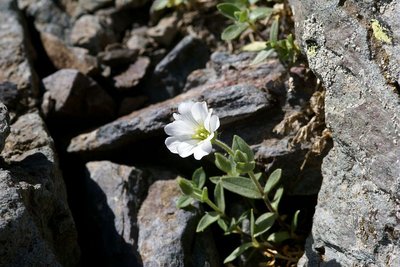
Céraiste à larges feuilles - Cédric Dentant - PNE  Flora
FloraChickweed
It illuminates the scree that the névé take their time to free. Nestled and sticking in the rock, it amazes walkers who admire its delicate foliage and pure white flowers in such a grey environment. How does it manage to produce such exuberant flowers in such a hostile environment though? Beneath the stones, it develops a network of roots that enable it to get vital nutriments from the waterlogged soil when the snow melts. It also produces pliable shoots that always find a place to latch on in the scree.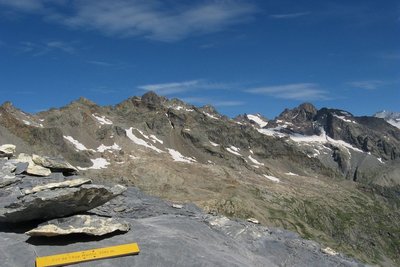
Vue depuis le col de l'Aup Martin - Thierry Maillet - PNE  Geology and geography
Geology and geographySchist sheets
The Col de l'Aup Martin is a surprising desert of dark grey, shiny schist forming fine parallel sheets. The rock was formed under techtonic influence that laid down the minerals making up the rock in parallel layers. Highly friable, the rock makes access to the col slippery or even dangerous, according to the weather conditions, and has given the col its poor reputation: a monstrous col according to Simon. Exactly like the Mordor region described by Tolkien in The Lord of the Rings, says François!

Gypaète barbu posé avec un os - Mireille Coulon - PNE  Fauna
FaunaBearded vulture
During a worldwide count organised in October each year, an observation post is set up in Le Pré de la Chaumette. The bearded vulture has already been spotted, but alas not each time! Falsely accused of carrying off lambs and children, this large bird with a wingspan of 2.80 m has been persecuted by man. Shooting, capture, poison, together with the scarcity of its food sources led to the bird’s extinction in the Alps in 1930. A European programme to reintroduce it was launched in 1986. Since then, the bearded vulture has been regaining ground.
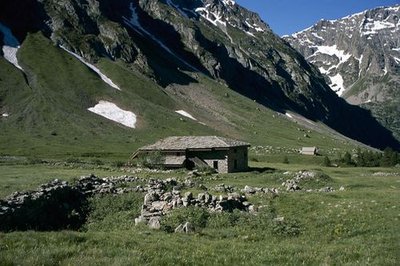
Le refuge du Pré de la Chaumette, Champoléon - Marc Corail - PNE  Pastoralism
PastoralismChaumette Meadow
The refuge is situated in a vast meadow formed by alpine grasslands that benefit from deep soil, on gentle slopes that are covered with snow on an average of eight months a year.
Source

Report a problem or an error
If you have found an error on this page or if you have noticed any problems during your hike, please report them to us here:

